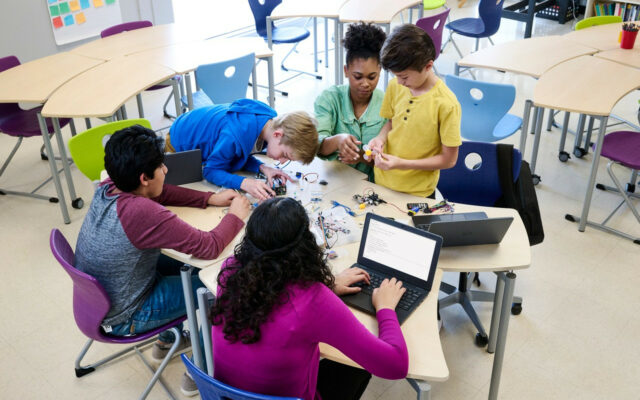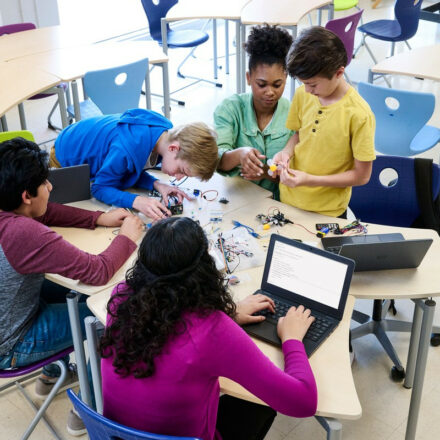When the United States first confronted the perils associated with the COVID-19 pandemic, school leaders took urgent action to ensure learning could continue at home by equipping their students and staff with laptops and tablets, scaling the number of school systems that could function in a one-to-one learning environment. As a March 2022 survey illustrates, the number of districts equipping their learners with anytime, anywhere access skyrocketed.
Our educators cemented technology integration as an essential component of the learning experience. However, the federal stimulus funds that helped fuel the rapid adoption of technology are ending, and many technology departments are left scratching their heads trying to determine how they can sustain a computing program with reduced fervor surrounding what has become an essential learning tool.
Sustaining a one-to-one program is far more than getting devices to students, and our checklist, Designing Student Access for Equitable Learning, can help ensure we lead with learners first. From a practical perspective, however, school systems still need to identify operational steps to bring their one-to-one goals to fruition. Schools that successfully adopted one-to-one learning before the pandemic operationalized their approach using a variety of tactics.
Inventory Your Devices and Infrastructure
During the pandemic, schools rapidly undertook the process of obtaining, preparing and distributing devices, so it is especially important to centralize your inventory before moving forward. Take stock of what you already have and align it to your student population. Gather data on students, devices, service/asset tag, building location, end-of-year warranty, Auto Update Expiration (AUE), device status, expected lifespan of device and expected rate of breakage to account for “spares.” Engaging in this process will give you the quantitative data you need when you begin to plan and strategize for how you will sustain your program going forward.
Map the Full Lifecycle of Your Devices
Create a process flow diagram of how devices will come and go through your district. Consider the following questions when creating your flow diagram:
-
- What are your buying processes and milestone dates?
- When and where will the new devices arrive?
- What will happen to the boxes when they arrive?
- How will you asset-tag and inventory the devices?
- Where do they go before they actually get into students’ hands?
- What is the process of addressing a broken device?
- How often will you collect devices? Will there be a summer refresh? Where will they be stored until re-distribution?
- At their end of life, how will you sustainably dispose of them?
Once you have a completed flow diagram, identify where you can create efficiencies.
Your SLA and Metrics
Create an internal service-level agreement you can advertise to your learning community. How long can a student be without a device? If we recognize that technology is an essential component of the learning process, then being without a device adversely affects learning. From the moment a device needs to be fixed, how long will it take for it to be fully functional? Once you have an agreement, create a metric to track on a regular basis that shows if you are meeting your own expectations.
Assess Cybersecurity
Every device you bring into your environment can be a potential vector for a cybersecurity threat actor. 70% of security breaches originate from an endpoint. Any device you are going to connect to your network needs to ensure all necessary measures of cybersecurity have taken place. Devices in students’ hands also have a compounding issue of threatening student safety.
Refine the Student Experience
From the moment a student opens a laptop, schools can alter the experience to support learning outcomes. A few times a year, stand behind students while they open their laptop and begin to work. Are there ways to structure your SSO to streamline access to important information? Consider your role in creating a digital learning environment that removes barriers to allow students to flourish.
Use Partners Wisely
Most school systems share their goals with solution providers. Companies like Dell want to help schools be successful; it is an essential component to our business. The more transparent schools are with their goals, the more likely providers can approach schools with a valuable solution. Identify areas where partners can help you become more efficient and effective and then challenge them to demonstrate solutions that help.
Evaluate Different Funding Models
School systems have had access to a significant amount of federal funding over the past three years. Much of the funding dedicated to technology will not be available after this school year. Determining the total cost of ownership of your program can help make the costs predictable and should be able to track the fluctuations of student populations, which has also been harder to determine as of late. As federal funding declines, reevaluating long-term solutions, in conjunction with senior leadership of your school system, will be an important step in providing stability in expectations from your teaching and learning staff. For example, many school systems fund their technology and services needs through a lease. But is this right for you? Would it be better to fund 25% of your client fleet every year for a four-year refresh? Or would it be better to swap out your entire fleet every four years? These are not easy questions to answer, but if we can add predictability to the process, the resulting stability allows teaching and learning to continue their transformational approach to the student experience.
To learn how you can partner with Dell to sustain your one-to-one student device program, click here.


